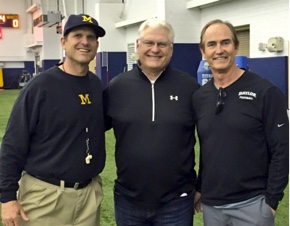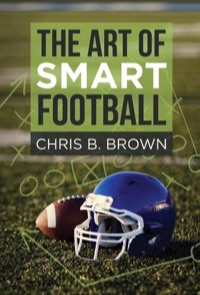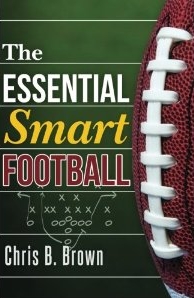Clinic season. Springtime is when coaches get together and — to some extent against their own interests (though not entirely) — share information on the ins and outs of their schemes, personnel strategies and general program management. Sometimes this involves one staff visiting another, but the backbone are the clinics, where (typically) college and sometimes NFL coaches give presentations to (typically) high school and small school coaches. There’s an entire ecosystem around these, both as informal job fairs and also as increasingly corporatized events, but they remain tremendously valuable sources of information (even though coaches are more guarded in the age of the internet than they used to be) and an area where the culture of football coaching culture remains unique.

Just three guys talkin’ ball
Jim Harbaugh – Coach Harbaugh talked about the type of coaches they’re looking for. Experts in their field. High character people that represent Michigan. Great motivators. Positive energy. Coach Harbaugh also talked about how to spot coaches that they don’t want. He doesn’t want people on his staff that “Coach like Costanza.” He talked about a Seinfeld episode where George reasoned that if you act frustrated and angry, everyone will assume you’re working harder. Doesn’t want coaches who are standoffish. Most times those coaches pretend to know everything because they’re afraid of getting exposed. Don’t be afraid to say I don’t know, but let’s work together to figure it out.
John Harbaugh – John went through a few of the staples of his coaching philosophy
- Build it the way you believe in. Not what you think someone else wants. They’ll run you out either way.
- Don’t do the job to keep the job. Do what you believe is right.
- Coaches compete everyday. With each other (game plan) and against each other (practice)
- Never stop learning, you can always get better. He talked about how he picked up some power run game ideas from one of the high school speakers, Akron Hoban (OH) Head Coach Tim Tyrrell.
- It’s not about what you can’t do. Find what you can do. There is opportunity in everything and everywhere. He mentioned a free agent that they lost recently. Rather than dwelling on the loss, Coach Harbaugh said “We’ve got a different path now. Different opportunity. Maybe we can add another pass rusher now, or rebuild the OL to run some different schemes. Find a way.”
- Football provides an opportunity that no other sport can. Everyone can be a part of the team and contribute in some type of meaningful way, scout team etc. Roster isn’t limited like basketball or baseball.
James Light also has good stuff from Detroit Lions defensive coordinator Teryl Austin (Austin: “We encourage good body language. Bad body language… fosters resent and divineness.” Light: “[Austin] use[d] specific plays from film as examples of bad body language to convey the point…. Coach Austin pointed out the reaction of Louis Delmas after the touchdown. That was the type of body language that they won’t tolerate…. It creates dissension within the team and shows weakness to the opponent.”) and new Michigan defensive coordinator Don Brown:
Defending the Spread Run Game: In terms of defending zone option, Coach Brown will use a PUP technique for his defensive ends, also commonly referred to as squeeze and pop. The defensive end being read will play the QB and the bend (RB cutback) on zone. The unblocked defensive end will stay square and shuffle flat down the line of scrimmage to close the space on any zone cutback. If the Quarterback keeps the ball, then the defensive end is chasing the QB from the inside out to his help. Coach Brown stressed that you have to get the defensive ends help versus zone option. You can’t just assign the DE to the QB with no help and expect him to take away the zone cutback and be able to run down a Quarterback like Deshaun Watson.
Meanwhile Coach Bird has high level notes from essentially every speaker (all the Harbaughs, Pees, Martz, Marc Trestman, Leslie Frazier, Juan Castillo) at the Michigan clinic. And, of course, Art Briles recently announced that Jim Harbaugh will be speaking at his Baylor clinic.
Football technology. There’s no question that in ten or twenty years, many aspects of coaching and playing football will be very different, with technological changes being the biggest driver: efficiencies in film study, player evaluation, data tracking, and teaching methods will have a huge impact on the game. I recently got a demonstration of STRIVR’s virtual reality system, about which I’ll have more to say in the future (the short version is that it’s a tremendous tool and really fascinating, and when a 330 pound nose tackle came at me I couldn’t help but get my hands up to punch him away), but VR will only be one component of the many coming changes.
But, as has been the case more generally, much of the impact of technology on football will be on improving communications. ESPN’s Kevin Seifert has a story about improving something that probably should have been fixed twenty years ago — the perpetual story about one team’s headsets “going out” in the middle of games — but it contains some interesting nuggets about future applications:
Finally, the Internet-based structure will allow for future additions to complement sideline technology. Imagine, for example, a digital play sheet on a quarterback’s wrist that changes based on signals sent in by a coach.
Of course, if the digital play sheet can change based on signals then wouldn’t it be easier to push a button to make the playcall appear on the QB’s digital wrist device and skip manual signals altogether (something that can’t be all that difficult with Apple Watches around)? In any event, the upshot is that this is where it’s all going. Now, the NFL (and especially college football) tends to like to restrict communications like this, preferring the pitfalls of older technology to encouraging a technological arms race, but technology will begin popping up and there’s no question it will eventually be an important part of NFL and college on-field communication. (True story: I played on a team where our opponent’s coaches went over to our offensive coordinator before a game, ostensibly to say “Hello,” but really so they could see what frequency the radio transmitter on his hip was set to. The opposing coaches then listened to all of my team’s playcalls (we lost), and then bragged about it after the game to the parents of one of my teammates over drinks, who for some unknown reason, thought it was funny that their son’s team was cheated out of a game (by the coaches, no less) and told everyone else. So, bring on the Apple Watches.)
Mouse’s Run and Shoot tapes. I recently stumbled on some great old videos on the Run and Shoot from maybe its most famous proponent, Mouse Davis. While I don’t (necessarily) advocate anyone running the “pure” Run and Shoot now, it remains one of the most fruitful offenses for study. (Plus Mouse is always fun to listen to.)
Twitterversary. Twitter turned ten years old on Monday, which I for some reason find a terribly depressing fact. (Though now we have an algorithm that can identify drunken tweets so, yay progress.) The New York Times asked some important twitter users about Twitter, and here’s football-twitter king Adam Schefter:
Twitter has ramped up the news-cycle speed to unimaginable levels. News emerges, it spreads, people react, and within minutes, the story is widely disseminated and analyzed. It’s one of the best parts of Twitter, maybe the best part: the ability to inform. Information pours out on Twitter.
We miss the dominant newspaper days, though it’s hard to pinpoint how much of that has to do with the evolution of Twitter and the digital day we’re now living in. Had neither come along, we might still be sitting at the kitchen table, sipping our coffee, reading the newspaper, rather than hearing about who the next Supreme Court justice is, at almost the same time he is selected.
Let’s set aside the oddness of using the nomination of a Supreme Court justice as the example (the news of the most recent Supreme Court nominee, Merrick Garland, broke only moments before the President conducted a nationally televised press conference announcing his nomination), but it seems to me that Twitter qua Twitter doesn’t do much for the really big stories — earthquakes, wars, national tragedies, political issues, and so on. Yes, those of us on Twitter often read about those things faster than, say, if we waited for the stories to be printed in the newspaper, but making that jump ignores the fact that things like (a) television and (b) the rest of the internet (to say nothing of other social networks) also exist, which tend to do a pretty decent job of very quickly identifying major breaking news (which Schefter acknowledges). Instead, the information flood that Twitter excels at is an ocean of irresistible but ultimately meaningless minutiae, with the announcement of various personnel transactions in a made up game being a prime example. (The philosopher Bernard Suits once defined a “game” as “the voluntary attempt to overcome unnecessary obstacles”.)
But Schefter is surely right that the speed-race for breaking these kinds of silly but heavily trafficked tidbits is increasing every year, with Twitter being a prime culprit, which I suppose is yet another reason why I and so many others find it difficult to celebrate this ridiculous, seemingly poorly managed service that we nevertheless all spend so much time using.
Football and toenail fungus. This is only tangentially related to football, but Valeant — who has, uh, had a rough go of it recently — put out a commercial for its toenail fungus drug, Julia, in which a toe wearing a football helmet tackles toenail fungus (which is carrying a football) before a cutaway to an Xs and Os diagram of toenail fungus — just watch it (or, maybe, don’t):
So that’s both disgusting and ridiculous, though admittedly when it comes to advertisements for treatments of foot ailments it’s tough to improve on John Madden selling Tinactin. But it turns out the football toe commercial is not just a silly, it also drew the ire of the Food and Drug Administration:
The Food and Drug Administration wants to know if these memorable images skew perceptions of risks associated with medications. In a document posted online Tuesday, the agency outlined plans to study how consumers process live action and animated ads….
“Personifying animated characters may interfere with message communication,” the FDA said in the document. “Whether personified characters lead to reduced comprehension of risk and benefit information in drug ads is an important and unanswered question.”
As Matt Levine points out, the interested reader may have the chance to get involved as the study involves 1,500 people watching these ads followed by an online survey. But if you ask me they should just bring back John Madden.
Louisiana’s budget crisis. A few weeks ago Louisiana governor John Bel Edwards announced that the Louisiana state government was in such a deep, sustained fiscal crisis that budget cuts were inevitable, and the programs affected could even include LSU football:
In a rare statewide televised address, Edwards told viewers that the state would be forced to take extreme action — such as throwing people with off of kidney dialysis and shutting down hospice services — if new taxes didn’t go into place over the next few months. . . .
The governor didn’t stop at health care services, but also detailed catastrophic cuts to higher education. He said new revenue was needed to prevent universities from running out of money before the semester ends. LSU, the state’s wealthiest higher education institution, would only be able to pay its bills through April 30, unless some tax increases went into place.
The governor went so far as to say that LSU football was also in jeopardy, due to a threatened suspension of spring classes that would put college athletes’ eligibility in danger next year. . . . “Student athletes across the state would be ineligible to play next semester,” Edwards said. “I don’t say this to scare you. But I am going to be honest with you.”
So none of that is good, and while cuts to football shouldn’t be equated with more important programs like education and other mainstay public programs, it certainly gets people’s attention. And the outlook for football at universities outside of LSU is even worse:
The Southern University System, and University of Louisiana System, and the Louisiana Community and Technical College System are in the same boat: without legislators approving new revenue this special session, some campuses will be forced to declare financial bankruptcy, which would include massive layoffs and the cancellation of classes.
If you are a student attending one of these universities, it means that you will receive a grade of incomplete, many students will not be able to graduate and student athletes across the state at those schools will be ineligible to play next semester. That means you can say farewell to college football next fall.
I was reminded of this depressing state of affairs while reading this article on the broken public defender system in Louisiana, which already had a mixed record to begin with:
The constitutional obligation to provide criminal defense for the poor has been endangered by funding problems across the country, but nowhere else is a system in statewide free fall like Louisiana’s, where public defenders represent more than eight out of 10 criminal defendants. Offices throughout the state have been forced to lay off lawyers, leaving those who remain with caseloads well into the hundreds. In seven of the state’s 42 judicial districts, poor defendants are already being put on wait lists; here in the 15th, the list is over 2,300 names long and growing. . . .
With felony caseloads already far above the professional standard, the public defender concluded that turning down cases was the only ethical option…. Even if state funding remains stable, however, more than half of the public defender offices could be under austerity plans by the fall, turning away clients and laying off lawyers.
“It is in shambles,” wrote District Court Judge Jerome Winsberg in a recent ruling, in which he sought private lawyers to represent several jailed defendants. “Things were not good before, but they are in a terrible place now.”
Other stuff:
– Economics of animated movies: “An executive producer who wants to cut costs has only two choice curbs: water and hair. Those are the most expensive things to replicate accurately via animation. It’s no mistake that the characters in Minions, the most profitable movie ever made by Universal, are virtually bald and don’t seem to spend much time in the pool.”
– Mark Richt on handling the blitz.
– The Solid Verbal had some great podcasts with coaches Tom Herman, DJ Durkin and Bronco Mendenhall.
– Ian Boyd on Katy Texas’s staunch 3-4 defense.







